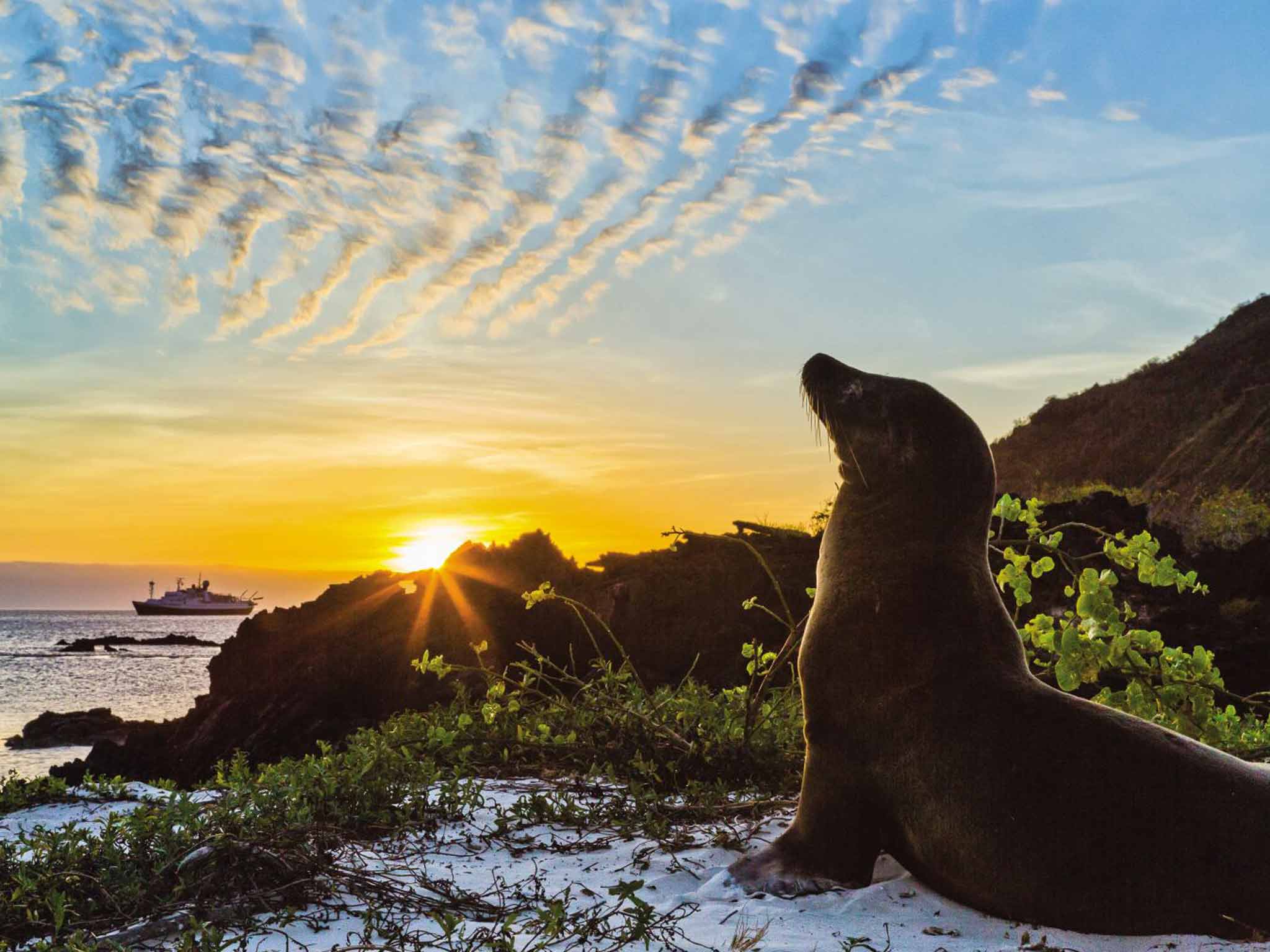Galápagos cruise: The laboratory of evolution
Joining a pioneering cruise company, Leslie Woit follows in the wake of Darwin

My white robe slipped to the floor and our eyes locked at short distance, his pupils wide and brown, his hide dark and leathery. A steamy equatorial breeze tickled our skin and his whiskers twitched as he belched.
Hey, what was he snorting about? I wasn't the one with the flies round my face and sea lion blubber tipping the scales at 250kg.
One thousands kilometres off the coast of Ecuador, the Galápagos islands are a theatre in the wild. Surrounding my personal floating-massage pontoon were blue-footed boobies and red-throated frigate birds, while beneath the glass peep hole were diving penguins and rainbows of fish. There are creatures here that are found nowhere else on Earth – flightless cormorants, marine iguanas, Darwin's beloved finches, and great tortoises that grow to more than 300kg and live for more than 100 years. All arrived long ago – by air, on ocean currents, and atop rafts of vegetation that bumped ashore against all odds.
My massage was a rare hour of inactivity on a seven-day voyage with Lindblad Expeditions, where the ship is a tool for research and we were “explorers”. National Geographic Endeavour is a 96-passenger expedition vessel, staffed by expert naturalists and photography instructors, there to teach everyone from aspiring pros dangling femur-length lenses to point-and-shoot grandmothers.
The Galápagos were made a national park in 1959 to mark the centenary of the publication of Darwin's On the Origin of Species, and today 97 per cent of it is protected parkland. Lars-Eric Lindblad was the first to bring tourist explorers here in 1967 and he takes the islands' environmental stewardship seriously: the company and its guests have raised more than $5.5m (£3.6m) for conservation; a trail system built in the Seventies, which visitors must follow to limit damage to the fragile ecosystem, is credited with keeping the impact to a minimum while still allowing interaction.
But much has changed since the first tourists sailed here. Our Darwinian curiosities now receive hi-tech support: snorkel gear, kayaks, wetsuits, video chroniclers, splash cams, and a glass-bottom boat. One moment we were snorkelling amid shoals of rainbow-striped king angelfish, while brown pelicans and blue-footed boobies dived like Stukas at dawn; next, we were hiking with a naturalist on San Cristóbal's gigantic furled ashtray of hardened lava; then it was a rush to pull on our wetsuits for an underwater photography session.
My first marine encounter in warm Pacific water, off Isabela Island, was with a six-foot white-tipped shark about three metres away, followed by a real-life, HD docudrama of parrotfish and Cortez rainbow wrasse, frolicking sea lions and Zeppelin-like sea turtles.
“Watch where you step, they're everywhere,” one of my shipmates warned as we clambered off the inflatable that ferried us from the ship to Fernandina, one of seven of the Galápagos's 13 main islands on our itinerary. At our feet lay a motionless carpet of horrifying beauty: hundreds of sluggish, scaly marine iguanas. As I tip-toed across hardened lava, it was a challenge to avoid 20cm-long tails and those beady eyes looking in all directions at once.
“There is nothing introduced on Fernandina,” said Sofia Darquea, a naturalist guide with the Charles Darwin Research Station. “This is one of the largest pristine islands in the world.”
As Darwin discovered in this “laboratory of evolution”, the Galápagos put a particular kind of wild into wildlife. With few predators, birds, mammals and reptiles exist in relative harmony.
“Let's keep moving –the Galápagos are too spectacular to see only through a tiny lens,” naturalist and photo instructor Jeff Litton advised. On cue, a razor-straight formation of greater flamingos strafed the beach – a brush of pink on teal forever caught in memory if not on camera.
Naturally, Jeff bagged the money shot (he is a National Geographic photographer after all). This and many other images were displayed over drinks later in the ship's lounge. Each night there was a lecture or photography clinic that covered everything from F-stops to shooting moving birds, and tips on how to frame a shot.
“Think about this: it takes 15 days to float from mainland Ecuador to Galápagos,” explained naturalist Ruly Menoscal, as we admired a metre-wide giant tortoise, one of 11 remaining species on the islands, down from 15 when Darwin stepped ashore. This brought home how far the first creatures must have travelled to reach the islands, all those millennia ago. They floated, heads high, to win the evolutionary race. Even for humans with access to planes and ships, reaching the Galápagos is an effort. But whether you're toting a camera, a sketchbook or a notepad, its rewards are great.
Getting there
Lindblad Expeditions (001 212 261 9000; expeditions.com) offers 10-day Galápagos trips from $6,590pp (£4,393). The tours include a full-board cruise on the National Geographic Endeavour, two nights in a hotel, all activities and excursions. There are no direct flights between the UK and Ecuador; the usual approach to the Galapagos is via Amsterdam, Madrid or Miami to Guayaquil, followed by a domestic flight to the island of Santa Cruz or San Cristóbal.
More information
Subscribe to Independent Premium to bookmark this article
Want to bookmark your favourite articles and stories to read or reference later? Start your Independent Premium subscription today.

Join our commenting forum
Join thought-provoking conversations, follow other Independent readers and see their replies